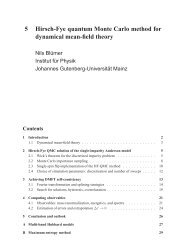Hubbard Model for Asymmetric Ultracold Fermionic ... - KOMET 337
Hubbard Model for Asymmetric Ultracold Fermionic ... - KOMET 337
Hubbard Model for Asymmetric Ultracold Fermionic ... - KOMET 337
Create successful ePaper yourself
Turn your PDF publications into a flip-book with our unique Google optimized e-Paper software.
2.4. PROPERTIES OF THE SELF-CONSISTENCY EQUATIONS 15directly leads to a chemical µ = U 2a particle-hole trans<strong>for</strong>mationpotential at half-filling. It is well-known that per<strong>for</strong>mingc † iσ→ exp(iQ · i)c iσ, (2.56)c iσ→ exp(iQ · i)c † iσ,Q = (π,π,... ,π) T ,leads to the desired result, if the lattice is bipartite. Furthermore, the model is symmetricunder a spin exchange trans<strong>for</strong>mation:c † iσ → c† i−σ; c iσ→ c i−σ. (2.57)If we take the Hamiltonian (2.1) at B = 0, particle-hole symmetry still leads to µ = U 2 athalf filling. Spin-exchange symmetry is however broken, the trans<strong>for</strong>mation (2.57) leads to amodified hopping termH T → − ∑ t −σc † iσ c jσ, (2.58)(ij)σso that particles hop with the hopping-amplitude of the opposite spin species.The Hamiltonian (2.1) at t ↑ = t ↓ ≡ t is neither symmetric under the trans<strong>for</strong>mation (2.56)nor under (2.57). But if we combine both trans<strong>for</strong>mations at µ = U 2, we get our symmetryback:HS.E. −−→P.H.− ∑ t c † iσ c jσ + U ∑ (1 − n i↑− n i↓+ n i↑n i↓) (2.59)(ij)i− U ∑(1 − n2 iσ) − B ∑ σ(1 − n iσ)iσiσ= − ∑ t c † iσ c jσ + U ∑(ij)i= H ,so that we still have half filling at µ = U 2 .n i↑ n i↓ − µ ∑ iσn iσ + B ∑ iσσn iσIf both B ≠ 0 and t ↑ ≠ t ↓ , these arguments do not work and there<strong>for</strong>e the calculation ofthe chemical potential at half filling becomes more complicated. These symmetry relationswere shown <strong>for</strong> the exact model, but they are still valid in the Hartree-Fock approximation,where some of the operators have been replaced by averages.These symmetry relations at half filling can be used to reduce the numerical problem ofsolving the self-consistency equations by one parameter, since at µ = U 2, under the conditionsdiscussed above, (2.47) reduces exactly to n = 1 at all temperatures and needs not to besolved numerically.2.4.3 Non-polarized solutions of first typeWe will distinguish two types of non-polarized solutions (m = 0). The first type of nonpolarizedsolutions, which we will discuss in this section, arises from the choice of the hoppingamplitudes t σ , the chemical potential µ and the magnetic field B occurring in the Zeemanterm. This type of solutions is non-magnetic even at U = 0, in contrast to the second type













